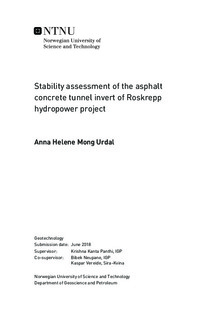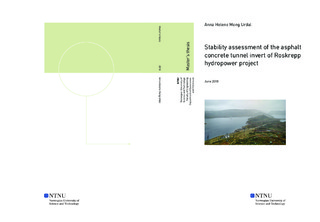| dc.description.abstract | Rebuilding a hydropower plant into a pumped-storage plant in an underground tunnel, means that the water will rapidly change directions, instead of streaming evenly in one direction. This will cause extra water pressure in the headrace tunnel and can cause stability problems that can damage the turbines. The hydropower plant, Roskrepp, is being considered to become a pumped-storage plant. During the construction of the hydropower plant, an asphalt layer was put at the floor. With rapidly change of water pressure, the asphalt can tear up and cause damage to the turbines. Investigation of the rock condition along the tunnel alignment and an assessment of the asphalt lining in conjunction with the possibilities of pumped-storage plant for Roskrepp has been done.
To evaluate the problem, literature research, field investigation, laboratory testing on rock samples, numerical analysis and physical model test has been carried out.
The stability assessment of the rock mass included literature study, field investigation, laboratory testing and numerical analysis. One of the six possible weakness zones crossing the tunnel area, appears to be more crucial regarding the stability of the tunnel. This could be of crushed rock material. If extra pressure occurs, a caving situation can happen in the ceiling. Erosion under asphalt from the crushed rock materials can also cause instabilities. With water streaming under asphalt lining, the crushed rock can erode and tear up the asphalt lining. Eventually the materials can stream down to the turbines and cause destruction.
The assessment of the asphalt lining included literature study, numerical analysis, and physical model test. If cracks are developed in the asphalt, or the contact between the asphalt layer and the rock walls are not fully sealed, water can easily stream under the lining and disturb the aggregate under it. Literature study and physical model test results shows that pressure under asphalt lining is delayed comparing with pressure over asphalt lining when mass oscillation is present. If a fine combination between trapped air and water under the lining are present, there will be a possibility of lifting the asphalt when mass oscillation is on its way down. This can cause tearing up the asphalt and destroy the turbines. | |

